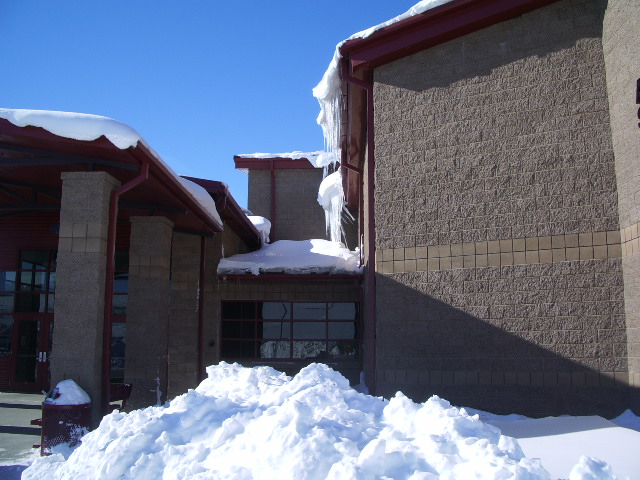- Products
- Industries
- Project Gallery
- Resource Center
- Metal Institute
- Services
- Shop
- Contact Us
For additional questions or to learn more about our panels reach out to our team of experts.
December 10, 2024
by MBCI

Did you know that snow accumulation on the roof can be a severe safety hazard? Snow accumulation can lead to overloading and even structural collapse. The density of snow can vary greatly, resulting in ice buildup on the roof and creating hazardous conditions for anyone on or possibly beneath the roof. Thus, it is of utmost importance to closely monitor snow accumulation.
Prioritizing safety must always be the top consideration to ensure the well-being of those performing roof maintenance. It is imperative to use fall protection and other safety equipment as OSHA and other regulatory agencies require. It is also crucial to ensure that all personnel involved in maintenance are trained in safety procedures and use caution when walking on roofs with steep slopes, near roof edges or roofs covered with ice or snow.
It’s also important to remember that a building’s capacity to withstand a snow load depends on its design and the density of the snow. A building designed for a 30 psf snow load can withstand up to 18 inches of snow at a density of 20 pcf. It’s recommended to clear the roof of snow before half of the safe maximum snow depth is reached to prevent overloading the roof.
Furthermore, remember to take precautions when performing roof maintenance to avoid damaging the roof or putting yourself at risk. To prevent accidents, avoid walking on roof flashings such as gutter, rake, hip or ridge, and never step on light transmitting panels (LTPs) as they are not designed to bear a person’s weight. Ensure all LTPs and roof openings are guarded and step only on the flat panel on or near a supporting roof structure.
By prioritizing safety and taking the proper precautions, you can ensure that your roof is well-maintained and avoid any risk of damage to the building or those working on it. According to Section A9 guidelines of the 2010 Metal Building Manufacturers Association Manual, there is no specific depth of snow that a building can handle as the density of snow varies based on several factors like weather conditions during and after a snowfall and the total depth of snow in a particular location. Snow density changes as the snow melts, and not all water drains off the roof as the underlying snow absorbs some water from the melted snow above, leading to ice buildup on the roof as the temperature changes from day to night.
Fresh snow may weigh as little as 10 to 12 pounds per cubic foot (pcf), but the density increases as it compacts and becomes heavier with water. Depending on snow depth, typical densities on a roof will range from 16 pcf to 30. When there is snow on the roof of a building, and it rains, excessive loads can develop rapidly. Snow acts as a sponge in these conditions, and loads can approach the water weight, 62.4 pcf, or 5.2 pounds per square foot (psf) per inch of depth. Rarely will a cubic foot of snow and ice equal the weight of water due to the expansion as water freezes. However, these conditions must be monitored with extreme caution.
Snow accumulation can pose a risk to some building regions, such as firewalls, parapet walls, valleys, dormers and lower roof levels where there is a step in the roof. Modern building codes require that these areas be designed to support additional loads caused by snow buildup. Still, the variability of snow density means that the designs may only sometimes be sufficient.
Determining the maximum depth of safe snow is difficult, but building owners can approximate it by consulting the snow load the building is designed to carry. For instance, a building designed for a 30 pounds per square foot (psf) snow load can reach its design load with just 18 inches of snow at a density of 20 pounds per cubic foot (pcf). With wet snow conditions, the building could be overloaded with less than a foot of snow. Clearing the snow from the roof is the only way to prevent this. Factory Mutual recommends clearing roofs when the snow depth exceeds half of the safe maximum snow depth, which can be estimated based on the design snow load and snow and ice buildup density.
It’s essential to prioritize safety when performing maintenance on a roof. Walking on any roof can be dangerous, so fall protection and personal safety equipment are necessary. It’s crucial to comply with all safety guidelines, whether customary, regulatory, or statutory, to avoid injuries, death or fines for noncompliance.
Exercise extreme caution when walking on roofs with steep slopes, near roof edges or roofs wet or covered with ice or snow. All maintenance personnel should be adequately trained in safety procedures, and all equipment should be properly working.
When performing roof maintenance, follow these precautions:
– Use fall protection and other safety equipment as required.
– Do not walk on roof flashings such as gutter, rake, hip or ridge.
– Do not walk on Light Transmitting Panels (LTPs) as they cannot support a person’s weight.
– Guard all LTPs and roof openings.
– Step only on the panel flat directly on or near a supporting roof structure.
Check out the Metal Minutes Podcast to stay up to date on news and learn more about frequently asked questions!